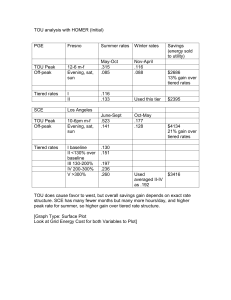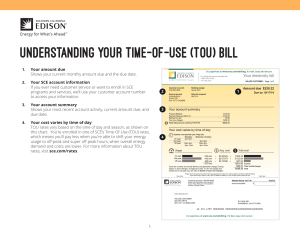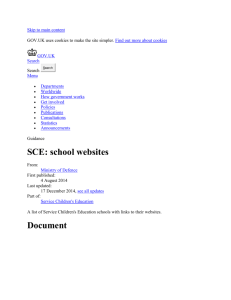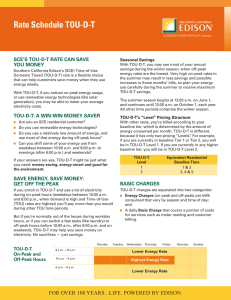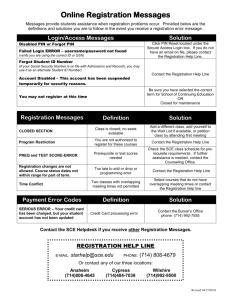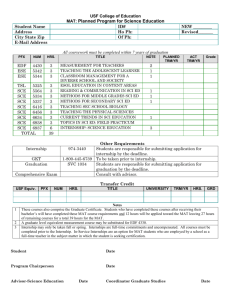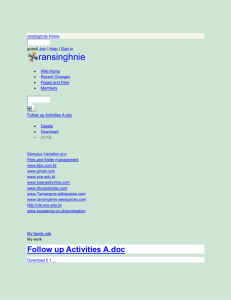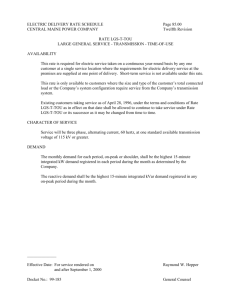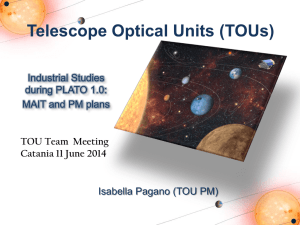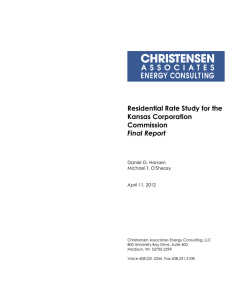PowerPoint Presentation from SCE
advertisement
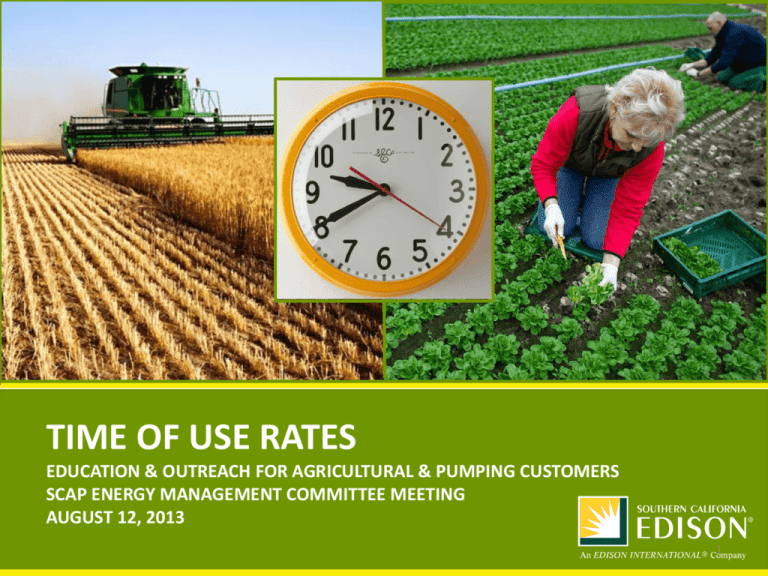
TIME OF USE RATES EDUCATION & OUTREACH FOR AGRICULTURAL & PUMPING CUSTOMERS SCAP ENERGY MANAGEMENT COMMITTEE MEETING AUGUST 12, 2013 1 BASICS: Time-of-Use Statewide Initiative WHO? Non-residential customers WHAT? Time-of-Use rates are determined by when you use energy (time of day, day of week, season) and how much you use. WHY? Time-of-Use is part of a statewide initiative designed to keep the grid reliable so everyone will have power when they need it. WHEN? GS-1 and GS-2 customers* will transition to TOU Jan. 2014 PA-1 and PA-2 customers* will transition to TOU Feb. 2014 *with 12 months of interval data as of July 31, 2013 2 Rate Analysis November 2013 Outbound Call Late October 2013 @ Rate Analysis Early October 2013 TOU Awareness September 2013 August 2013 OUTREACH: TOU Customer Communication Outbound Call SCE.com/TOU, My Account, Rate Analyzer, and solutions that will help customers with the TOU transition 120+ Events, including energy walks, chamber meetings, business forums and presentations Targeted banner ads, paid search, social media and other vehicles Digital Campaign 3 OUTREACH: SCE.com/TOU 4 SEASONAL: Traditional Time Periods Traditional Summer Time Periods Highest Energy Charge Medium Energy Charge Lowest Energy Charge Three different TOU periods: On-Peak: Highest Energy Charge Mid-Peak: Medium Energy Charge Off-Peak: Lowest Energy Charge Traditional Winter Time Periods Medium Energy Charge Lowest Energy Charge Holidays: Holidays are considered Off-Peak or Super OffPeak. When any holiday falls on a Sunday, the following Monday is recognized as the holiday 5 TIME PROFILE: Standard TOU Rate % Time / Number of Hours Average per Month Summer Winter 130 hours 18% 404 hours 55% On-Peak 196 hours 27% Mid-Peak Off-Peak 447 hours 61% Mid Peak 282 hours 39% Off Peak 6 RATE COMPONETS: Demand (kW) / Energy (kWh) Power (kW or Demand) is a Car Example measure of how quickly work is being done. The speedometer measures the rate at which work is being done - your Speed is like Kw 1kW = 1.341 Horsepower Energy (kWh) is a measure of how much work was done 1 kWh = Ten 100 watt light bulbs running for 1 hour The odometer measures how much work was done - Miles driven is like kWh Watts is a unit of power kW = 1000 Watts (kilo is 1000 times) 7 DEMAND EXAMPLE • Measured Demand is an average demand over a 15 minute interval 15 minute Demand Interval additional 21kW comes on 9kW shuts off 9kW 0 – 5 minutes: 9 kW x 1/3 of time = 3 kW avg. 5 – 10 minutes: 30 kW x 1/3 of time = 10 kW avg. 10 – 15 minutes: 21 kW x 1/3 of time = 7 kW avg. Total = 20 kW avg. 8 Typical Rate Schedules (Comm/Ind.) • TOU-8-B (Options A and B) – Maximum Demand Greater than 500kW – Facilities-Related & Time-Related Demand Charge – Energy Charge (based on Peak Period) • TOU-GS-3 (Options A and B) – Maximum Demand Between 300kW and 499kW • TOU-GS-2 (Options A and B) – Maximum Demand Between 20kW and 299kW) • TOU-GS-1 (Options A and B) – Maximum Demand Between 0kW and 19kW) 9 Typical Rate Schedules (Ag/Pumping) • TOU-PA-3 (Options A and B) – Maximum Demands Between 300kW and 499kW) • TOU-PA-2 (Options A and B) – Maximum Demands Beetween 20kW and 299kW) • TOU-PA-1 (Options A and B) – Maximum Demands Between 0kW and 19kW) • TOU-PA-2-RTP & TOU-PA-3 (Real Time Pricing) – Temperature-based rate, hourly pricing – Based on temperature recorded at LA Civic Center • TOU-PA-SOP (Super-Off Peak) – Beneficial to Customers Who Confine Majority of Usage to SOP Period 10 Agricultural and Pumping Time of Use Periods 11 Agricultural and Pumping Time of Use Periods 12 How Time-Of-Use Rates Work With Time-of-Use rates, the cost of electricity changes depending on the time of day you use it. Instead of a single flat rate for electricity use, the cost of electricity on a Time-of-Use rate varies based on the time of day, day of week, and season in which it is used. With Time-of-Use rates, when you use electricity is just as important as how much you use. 13 SM Standby and Departing Load (SB&DL) Response to Questions for Roundtable Discussion on Electricity Rates SCAP Energy Management Committee Meeting August 12, 2014 Project Management Technical Services B. Emerson, Sr. Project Manager DRAFT Business Customer Division SOUTHERN CALIFORNIA EDISON® SM Departing load charges and when are they applicable or not. • Departing Load (DL) tariffs apply to self-generation customer load that departed from SCE on or after 12/20/1995, with several exceptions. 1. DL tariffs pay for costs of Public Energy Policies. 2. Schedule DL-NBC (Departing Load NonBypassable) applies to load that departed on or after 12/20/1995. • Rate components: Nuclear Decommissioning Charge (NDC), Public Purpose Programs Charge (PPPC), and Competition Transition Charge (CTC). 3. Schedule CGDL-CRS (Customer Generation Departing Load – Cost Responsibility Surcharge) applies to load that departed after 02/01/2001, in addition to DL-NBC. • Rate components: Department of Water Resources (DWR) Bond Charge, Competition Transition Charge (CTC), and Power Charge Indifference Adjustment (PCIA). • Exemptions from Departing Load1: 1. 2. 3. 4. “Net Energy Metering Eligible” generators – e.g. Solar and Wind or Fuel Cells ≤ 1 MW Co-Generators1 are exempt from the CTC rate component, (PUC 372 and/or 374) CSI and SGIP Eligible1 generators are exempt from CGDL-CRS for the first 1 MW only Generators1 that meet BACT standards set by AQMD and/or CARB are exempt from PCIA rate component • DL is determined based on either the actual kWh output of the generator or a calculated estimate. 1. Calculated DL = Mo. Avg. kWh (over 12 months prior to Gen Ops) – less Current Month’s kWh Note 1: After State-wide Cap has been reached, CRS charges apply. Business Customer Division Project Management Technical Services SOUTHERN CALIFORNIA EDISON® Slide: 15 SM Standby charges and when are they applicable or not • Standby (SB), Schedule S, is required for all customers who selfgenerate all or part of their site load, with a few exceptions. • Permanent Exemptions for both SB & DL: 1. “Net Energy Metering Eligible” generators – e.g. Solar and Wind or Fuel Cells ≤ 1 MW 2. Backup/Emergency generators – operates only when there is a utility outage • Standby contract has two (2) demand level selections: 1. Supplemental Contract Capacity (SCC) kW = the Site Load that SCE will serve when the generator is normally operating or normally not scheduled to operate, e.g. night time. • 2. SCC kW is used in splitting the Summer On-Peak kW and Mid-Peak KW between Supplemental and Back-up Time Relate Demand for customers that do not have a SCE generator output meter Standby Demand (SB) kW = the load that the generator regularly serves and SCE is expected to instantaneously provide when the generator goes down, excluding any SCC . • • SB can not be more than the Generator Size nor Site Load; it excludes any SCC SB kW is used in offsetting the maximum demand in determining excess FRD Business Customer Division Project Management Technical Services SOUTHERN CALIFORNIA EDISON® Slide: 16 SM Do these charges vary and have limitations? – Do these charges vary based on the type of rate structure the facility is currently on? • Yes, similar to TOU, it is based on the site’s – Maximum Demand level (≤20, 21-199, 200-500, >500 kW), and – Service Voltage (<2, 2-50, 51-219, >220 KV). – The higher these values, the rates tend to be lower. • SB’s Capacity Reservation Charge is a monthly fixed amount based on the SB kW and charged regardless of monthly maximum demand – Are facilities with on-site generation in any way limited in their rate structure options? • Yes, they are limited to only Option B, (and TOU-S-RTP); i.e. no Option A, R or CPP • And they are also limited to TOU-BIP in the Demand Response programs. Business Customer Division Project Management Technical Services SOUTHERN CALIFORNIA EDISON® Slide: 17 SOLUTIONS: No-cost, Low-cost NO-COST TEMPORARY REDUCTION TIP CHECKLIST PERMANENT REDUCTION TIPS Where possible, shift operations to maximize lower cost time periods Use Variable Speed Drives (VSDs) instead of a valve to control flow Stagger equipment use to minimize demand Low Pressure Sprinkler Nozzles When you do not need all your pumps operating, use lower cost pumps first Controls for fans Plan your irrigation sets to maximize weekends and lower cost time periods. For seasonal operations, know the start of your billing period Make sure time clocks are set properly VSDs on Dairy Vacuum and Milk Pumps Install time clocks, sensors, to avoid higher cost periods Visit sce.com/EnergyTips for more customized tips and information by business type. 18 SOLUTIONS: Tools & Programs Tools • My Account • Budget Assistant • Business Energy Advisor • Rate Analyzer coming soon Express Incentives • Pumps Retrofits (25HP and less) • Sprinkler to Drip • Low Pressure Sprinkler nozzles • Various lighting solutions Customized Incentives Demand Response • Pump Retrofits • Variable Speed Drives: • Well Pumps • Vacuum Pumps • Milk Pumps • Fan Controls • Aeration/Controls • Agricultural and Pumping Interruptible (API) • Automated Demand Response • Aggregator Managed Portfolio (AMP) For more information about programs, incentives, and savings visit www.sce.com/solutions 19 Actual eligibility and incentives will be determined on a case-by-case basis, per individual program guidelines SOLUTIONS: SCE Pump Test • SCE’s oldest Energy Efficiency Program – Since 1911 • Tests are NO COST • Reasons to Test – – – – Track Pump Performance Budgeting Operational Planning Identify Inefficient pumps • To make arrangements for pump testing – Call (800) 634-9175 20 Contact Us Energy Efficiency & Demand Response Programs Optional Rates Detailed Rate Analysis Economic Development Services Other Products and Services Contact your account manager or: • www.sce.com/TOU • TouSolutions@sce.com • 1-866-743-1645 21 Questions??? • • • • James I Pasmore, Jr James.pasmore@sce.com Office: (714) 973-5759 Mobile: (714) 227-3283 22 APPENDIX 23 SOLUTIONS: Pump Test • PUMP TEST RESULTS LETTER INCLUDES: – Overall Plant Efficiency – If applicable • Estimate Savings if pump is retrofitted • Estimated Incentive – – – – Discharge Pressure Standing water level Pumping water level Discharge Head – – – – – – – – – Total Head Drawdown GPM GPM per Foot Drawdown Acre Feet Pumped in 24 hours kW Input to Motor HP Input to Motor % Motor Load RPM 24 TOU: HOLIDAYS • Holidays are considered Off-Peak or Super Off-Peak – – – – – – – – New Year’s Day Presidents Day Memorial Day Independence Day Labor Day Veterans Day Thanksgiving Day Christmas • When any holiday falls on a Sunday, the following Monday is recognized as the holiday – Note: no change will be made for holidays falling on a Saturday 25
